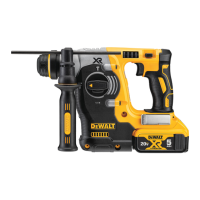8
English
Markings on Tool
The following pictograms are shown on the tool:
Read instruction manual beforeuse.
Wear earprotection.
Wear eyeprotection.
DATE CODE POSITION
The date code, which also includes the year of
manufacture, is printed into the housing surface that
forms the mounting joint between tool andbattery.
Example:
2016 XX XX
Year of Manufacture
Important Safety Instructions for All
Battery Chargers
SAVE THESE INSTRUCTIONS: This manual
contains important safety and operating instruc tions
for compatible batterychargers.
• Before using charger, read all instructions and
cautionary markings on charger, battery pack,
and product using batterypack.
WARNING: Shock hazard. Do not allow
any liquid to get inside charger. Electric
shock mayresult.
WARNING: We recommend the use of
a residual current device with a residual
current rating of 30mA or less.
CAUTION: Burn hazard. To reduce
the risk of injury, charge only
rechargeable batteries. Other types of
batteries may burst causing personal
injury anddamage.
CAUTION: Children should be
supervised to ensure that they do not
play with theappliance.
NOTICE: Under certain conditions, with
the charger plugged in to the power
supply, the charger can be shorted by
foreign material. Foreign materials of
a conductive nature such as, but not
limited to, grinding dust, metal chips,
steel wool, aluminum foil, or any buildup
of metallic particles should be kept away
from charger cavities. Always unplug the
charger from the power supply when
• Keep a firm grip on the tool at all times.
Do not attempt to operate this tool
without holding it with both hands. It is
recommended that the side handle be used at
all times. Operating this tool with one hand will
result in loss of control. Breaking through or
encountering hard materials such as re-bar may
be hazardous as well. Tighten the side handle
securely beforeuse.
• Do not operate this tool for long periods of
time. Vibration caused by hammer action may
be harmful to your hands and arms. Use gloves
to provide extra cushion and limit exposure by
taking frequent restperiods.
• Do not recondition bits yourself. Chisel
reconditioning should be done by an authorized
specialist. Improperly reconditioned chisels
could causeinjury.
• Wear gloves when operating tool or
changing bits. Accessible metal parts on the
tool and bits may get extremely hot during
operation. Small bits of broken material may
damage barehands.
• Never lay the tool down until the bit has
come to a complete stop. Moving bits could
causeinjury.
• Do not strike jammed bits with a hammer to
dislodge them. Fragments of metal or material
chips could dislodge and causeinjury.
• Slightly worn chisels can be resharpened
bygrinding.
• Keep the power cord away from the rotating
bit. Do not wrap the cord around any part of
your body. An electric cord wrapped around a
spinning bit may cause personal injury and loss
ofcontrol.
Residual Risks
The following risks are inherent to the use of rotary
hammers:
– Injuries caused by touching the rotating parts or
hot parts of thetool.
In spite of the application of the relevant safety
regulations and the implementation of safety
devices, certain residual risks cannot be avoided.
These are:
– Impairment ofhearing.
– Risk of squeezing fingers when changing
theaccessory.
– Health hazards caused by breathing dust
developed when working in concrete and/
ormasonry.

